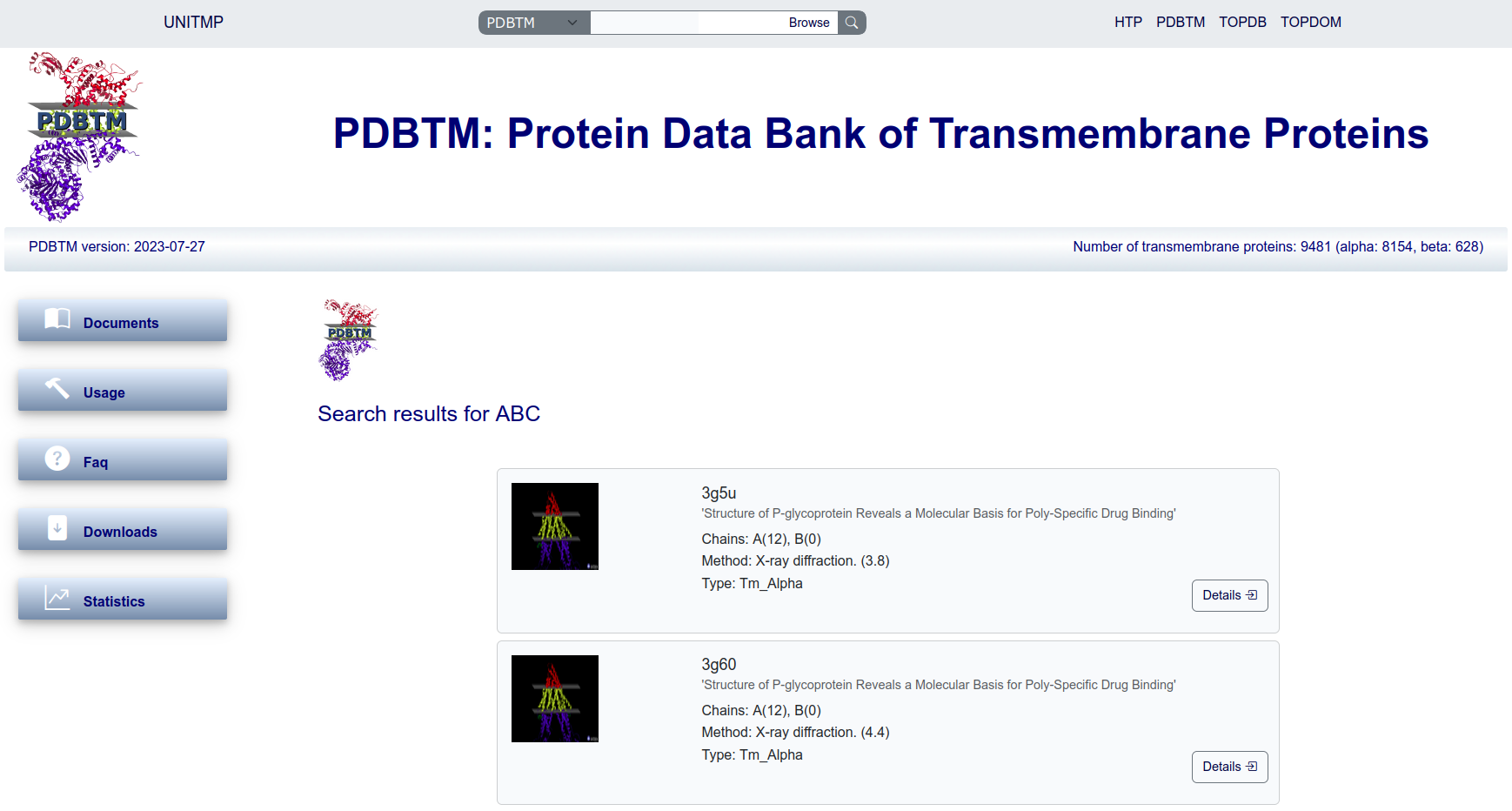PDBTM User Manual
Search
Users can enter any identifier or part of an identifier that is indexed in UniTmp database at the top of the page (A), including PDB code, UniProt Identifier/Accession, or domains/motifs from the following databases also incorporated into InterPro: Gene3D, TIGRFAM, PANTHER, PRINTS, Pfam, ProSiteProfiles, SMART, SUPERFAMILY. Users can also search for protein names. The results will appear in four lines, and will show results from PDBTM, TOPDB, TOPDOM and HTP databases. By clicking on any of the four categoriges a new list will appear with all entries related to the given query.
Users can also restrict results to the PDBTM database by selecting the scroll-down option "PDBTM" and then performing the search (B).
Browse
Users can browse the content of the PDBTM database using different filters using the browse button at the right of the search box (C). This includes pdb codes, type of the membrane protein (alpha/beta and number of transmembrane segments) and releases.
A few examples:
- for browsing by pdb code, we use a similar system also used by PDB: considering the 4-character code, users first have to select the second, then the second and third character to bring up all options. For example browse->by PDB codes->a->a0 brings up all PDB structures where the second character is a, the third is 0. For example 3a0b.
- for browsing bitopic alpha-helical structures, click on browse->by structures->alpha-> 1
- for browsing 2023 July first-week release, click on browse->by releases->2023->2023-07-07
List viewer
Once a search is performed, a list viewer page appears. In the case of searching in the whole UniTmp database, users first have to narrow down which source database they wish to use (D).
In the case of PDBTM, the list includes panels for each result, showing some basic information about the protein: a small pictogram of the protein (3D structure snapshot) on the left, pdb code, name of the structure, pdb chains and type of the protein (alpha, beta) on the right. Further details become available upon clicking on the Details button.
Entry viewer
The Entry panel consists of the following sections:
On the top users can download the TMDET output in xml and in json format, or the transformed pdb file (A). Link to the original pdb file on RCSB PDB is also available here. Users can also provide feedback if they find information incorrect or outdated. Although we spend a lot of time curating and updating information in UniTmp, many displayed information is automatic and may contain errors. We invite all users to submit comments so we can keep our resources updated and free of errors.
The second panel contains the 3D structure. Users can switch between related structures at the bottom of the panel. The structures are visualized in a way so the membrane plane is visible. The molecule can be rotated by dragging using the left mouse button while zooming in and out can be done using the mouse wheel (or with SHIFT+drag). A plethora of further settings is also available by clicking on the wrench icon, such as selecting residues, chains or changing visualization settings. The main panel contains the 3D structure, colored according to topology. The structures are visualized in a way so the membrane plane visible. The molecule can be rotated by dragging using the left mouse button while zooming in and out can be done using the mouse wheel (or with SHIFT+drag). A plethora of further settings are also available by clicking on the wrench icon (B), such as selecting residues, chains or changing visualization settings.
At the bottom topology of each PDB chain is visible, using the same coloring as in the 3D view. Users can click on ctrl+mouse wheel to zoom into the sequence (C). All entries are also linked to TOPDB database, where further topology information can be found about the full length protein (D).
Download
The PDBTM web server offers various files for download through the download menu. The first set of downloads offers various sets of raw PDBTM xml files. There are xml files for alpha-helical or beta-barrel transmembrane proteins separately (pdbtmalpha, pdbtmbeta respectively), or both in one file (pdbtmall). The file "pdbtm" contains all entries that are in the pdb database including transmembrane and not-transmembrane proteins as well. The next section of the download area contains only sequence information of the various sets defined above. The non-redundant sequence sets are produced by using the cd-hit algorithm with parameters "-c 0.4 -n 2 -l 30" (wordsize: 2, percent identity: 40%, sequence length longer than 30).
Updates
The PDBTM database is updated every week. To check out the latest release, the browse menu can be used: click on browse->by releases->"current year">"last date"
Statistics
The first part of the statistics page shows the monthly increase on a graph. It is followed by the weekly increase in tabular form. In both cases the statistics of alpha-helical and beta-barrel transmembrane proteins are shown separately as well.
API documentation
Click here to access API documentation.



